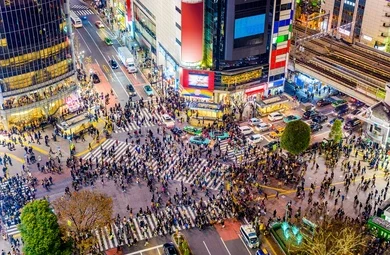In the heart of Tokyo lies Shibuya, not just a district but a living emblem of modern Japan. This bustling crossroads, renowned as one of the busiest in the world, is a magnet for international tourists, students, office workers, and locals going about their daily lives. But beyond the glow of neon lights and the sea of humanity crossing in perfect synchrony, Shibuya harbors tales and treasures that paint a richer picture of this iconic destination. Here are ten essential things you should know about Shibuya, the place that never sleeps.
- An Iconic Crowd Magnet
Shibuya Crossing, also known as Shibuya Scramble, stands as one of the most recognized pedestrian intersections on the planet. At peak hours, thousands of people cross simultaneously from multiple directions in what seems like a chaotic yet harmonious flow. This spectacle, particularly striking under the kaleidoscope of neon lights at night, has become a favorite among tourists, photographers, and filmmakers alike, showcasing Tokyo’s dynamic energy.
- A Shopper’s Paradise
Shibuya is a haven for shopping enthusiasts, home to some of Tokyo’s most renowned retail centers. Shibuya 109, a landmark mall, serves as the epicenter of youth fashion trends, while Shibuya Hikarie caters to upscale shoppers with luxury brands and art galleries. From global retailers to quirky local boutiques and vintage stores, Shibuya offers an unparalleled shopping experience.
- An Overlooked History
Before becoming the bustling district it is today, Shibuya was a quiet suburban area. Its transformation began with the establishment of Shibuya Station in 1885, which gradually drew more activity. However, it wasn’t always the busiest intersection in Tokyo; that title originally belonged to areas like Ginza and Asakusa. Shibuya’s rise to prominence came in the post-World War II economic boom when Japan’s rapid development turned the district into a hub of commerce and culture.
- Strategic Proximity to Shibuya Station
Shibuya Station, one of Tokyo’s major transportation hubs, connects multiple key railway lines, including the JR Yamanote Line, Tokyo Metro, and Tokyu Lines. This accessibility makes Shibuya a vital transit point, linking visitors and commuters to other major districts like Shinjuku, Ginza, and Yokohama. Its strategic location enhances its role as both a tourist destination and a bustling gateway to the city.
- Hachiko: A Monument to Loyalty
Amidst Shibuya’s modernity lies a heartfelt tribute to loyalty—the statue of Hachiko, the faithful Akita dog. For years, Hachiko waited daily at Shibuya Station for his deceased owner, a story that has touched hearts worldwide. Today, the statue serves as a popular meeting point and a reminder of unwavering devotion, attracting countless visitors who wish to honor this beloved tale.
- A Culinary Wonderland
Shibuya is a culinary treasure trove, offering an array of dining options that cater to all tastes. From authentic ramen shops and sushi bars to cozy izakayas (traditional Japanese pubs), the district is a gastronomic delight. For those seeking international flavors, Shibuya doesn’t disappoint, with trendy cafes and restaurants serving dishes from around the globe. It’s also a perfect spot to enjoy a cup of artisanal coffee while soaking in the vibrant urban atmosphere.
- A New Symbol of Tokyo’s Progress
More than just a bustling district, Shibuya represents Tokyo’s innovation and creativity. Its skyline is adorned with modern architectural marvels like Shibuya Scramble Square, offering panoramic views of the city. Shibuya Sky, an open-air observation deck, is particularly popular for its breathtaking sunsets and vistas of Mount Fuji, making it a must-visit for anyone exploring the area.
- Endless Entertainment Options
Shibuya is brimming with entertainment, from cutting-edge VR gaming centers like VR Park Tokyo to traditional bars and independent cinemas. A notable gem is Nonbei Yokocho, a narrow alley lined with tiny bars and eateries that transport visitors to the Tokyo of yesteryears. For a more futuristic experience, visitors can explore interactive art exhibits and high-tech attractions that reflect the city’s forward-thinking spirit.
- A Perennial Tourist Hotspot
Shibuya attracts tourists all year round, with winter being an especially popular season. Its proximity to Mount Fuji, which creates a stunning snowy backdrop, adds to the district’s charm. Tourists flock to experience the quintessential “Shibuya scramble” and capture the vibrant energy that defines Tokyo. Whether under a blanket of snow or amidst spring blooms, Shibuya never ceases to amaze.
- Something for Everyone
From high-fashion boutiques and delectable cuisine to cultural landmarks and modern entertainment, Shibuya truly has something for everyone. Fashion enthusiasts can explore the latest trends, foodies can indulge in a myriad of culinary delights, and fans of Japanese pop culture can discover unique shops selling anime and manga merchandise. Shibuya’s diverse offerings ensure every visitor leaves with unforgettable memories.
Conclusion: Tokyo’s Beating Heart
Shibuya is more than a district; it is the beating heart of Tokyo, where tradition and modernity converge. Its bustling streets, iconic landmarks, and vibrant culture make it a microcosm of Japan’s ever-evolving identity. Whether you’re crossing the famous scramble, sipping coffee in a cozy cafe, or gazing at the city from above, Shibuya invites you to experience Tokyo in its most dynamic and captivating form. For those planning a trip to Japan, Shibuya isn’t just a stop—it’s a destination that defines the essence of the city.

